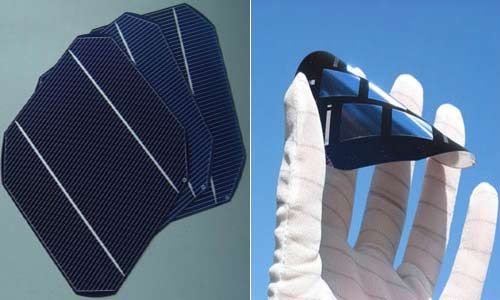Overview Of
Solar Cell Types
Solar cell types are broadly grouped into two categories - bulk(or wafer-based silicon) and thin film cells.
All solar cells require a light absorbing material to absorb photons and generate electrons via the photovoltaic effect.
Most solar cells are designed to absorb the wavelengths of solar light that reach the earth surface.

Some solar cells are optimized for light absorption beyond Earth's atmosphere, for use in "outer space"...
Solar panels are normally fabricated using either silicon or thin-film cell technology.
Many of the types of solar cells available are made from bulk materials that are then cut into wafers.
Other materials are configured as thin-films which are bonded to supporting substrates.
Nanocrystals are also used. These are placed as quantum dots (electron-confined nanoparticles) embedded in a supporting matrix.
Silicon is still the only substance which is well-researched in both bulk and thin-film cell technology.
There are new alternatives to silicon cells being developed.
Proprietary nanoparticle silicon printing will offer many features that conventional silicon cannot. It is the most promising of the new technologies.
Nanoparticle silicon can be printed reel-to-reel on stainless steel or other high temperature substrates.
Most of the work on the next generation of photovoltaics is directed at printing onto low cost flexible polymer film and ultimately on common materials. The main technologies looking promising are currently CIGS, CdTe, DSSC and organic photovoltaics.
If you want to gain a deeper understanding of the solar cell types, please read "bulk silicon solar cells" and "thin film solar cells".
Return From Solar Cell Types To Home Page